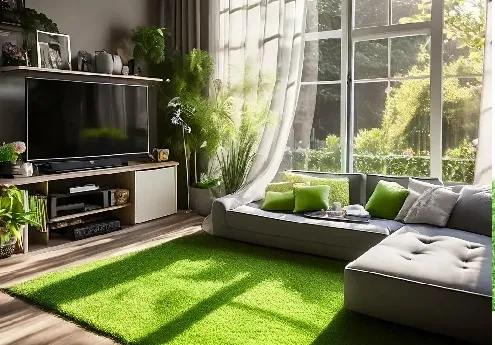
- Afrikaans
- Arabic
- Belarusian
- Bengali
- Czech
- Danish
- Dutch
- English
- Esperanto
- Estonian
- Finnish
- French
- German
- Greek
- Hindi
- Hungarian
- Icelandic
- Indonesian
- irish
- Italian
- Japanese
- kazakh
- Rwandese
- Korean
- Kyrgyz
- Lao
- Latin
- Latvian
- Malay
- Mongolian
- Myanmar
- Norwegian
- Persian
- Polish
- Portuguese
- Romanian
- Russian
- Serbian
- Spanish
- Swedish
- Tagalog
- Tajik
- Thai
- Turkish
- Turkmen
- Ukrainian
- Urdu
- Uighur
- Uzbek
- Vietnamese
artificial grass in hot weather
Oct . 05, 2024 04:16 Back to list
Artificial Grass in Hot Weather Pros and Cons
As summer rolls around and temperatures rise, many homeowners consider the benefits and drawbacks of installing artificial grass in their yards. The allure of lush, green lawns without the constant upkeep of natural grass is undeniable, especially in regions plagued by extreme heat. However, it's essential to weigh the advantages and disadvantages of artificial grass, particularly when it comes to hot weather conditions.
Advantages of Artificial Grass in Hot Weather
1. Low Maintenance One of the most significant advantages of artificial grass is its minimal maintenance requirements. In hot weather, natural grass demands regular watering to keep it green and healthy. This can be time-consuming and costly, especially in drought-prone areas where water restrictions may apply. In contrast, artificial grass does not require watering, allowing homeowners to save both time and resources.
2. Consistent Appearance During the summer, natural grass can become brown, patchy, or thin, especially if subjected to prolonged heat. This can lead to an unsightly lawn that detracts from the overall landscaping. Artificial grass, on the other hand, remains consistently green and well-kept regardless of the temperature, providing a year-round visual appeal.
3. Heat Resistance Modern artificial grass products are designed to withstand high temperatures without fading or deteriorating. Innovations in technology have led to the development of materials that are more resistant to heat, making them suitable for areas that experience scorching summers.
4. Durability Artificial grass is built to last. Unlike natural grass, which can be susceptible to wear and tear from heat, foot traffic, and pests, synthetic turf can endure extreme conditions. This durability means that homeowners can enjoy their lawns without worrying about constant reseeding or patching.
5. Reduced Allergens For individuals with allergies, artificial grass can be a blessing. Natural grass often produces pollen that can aggravate allergic reactions, especially during hot weather when it is in full bloom. Artificial grass, being synthetic, does not produce any pollen and can provide a more comfortable environment for allergy sufferers.
artificial grass in hot weather

Disadvantages of Artificial Grass in Hot Weather
1. Heat Retention One of the most significant drawbacks of artificial grass is its tendency to retain heat. In extremely hot weather, the surface temperature of synthetic turf can rise significantly, making it uncomfortable to walk on barefoot. This can be particularly concerning for pets, as their paws can burn on hot turf.
2. Environmental Impact While artificial grass offers water conservation benefits, it does have its own environmental concerns. The production of synthetic grass involves the use of non-renewable resources, and many types of artificial turf are not recyclable. This can contribute to environmental pollution and waste issues.
3. Installation Costs The initial cost of installing artificial grass can be substantial. While it saves money in the long run on maintenance and water bills, the upfront investment can deter homeowners who are looking for more immediate financial relief.
4. Limited Drainage While many artificial grass installations come with drainage systems, heavy rains can still lead to pooling water. In hot weather, this can create a breeding ground for mosquitoes and other pests, presenting health concerns.
5. Less Natural Feel For those who appreciate the aesthetics and feel of natural grass, artificial turf simply cannot replicate that experience. The sensory enjoyment of walking on soft grass can be lost with synthetic options, making it less appealing for some homeowners.
Conclusion
Artificial grass can be a viable solution for homeowners seeking a low-maintenance alternative to natural lawns, especially in hot weather conditions. Its advantages, including reduced maintenance and consistent appearance, make it an attractive option for many. However, potential drawbacks such as heat retention and environmental concerns must also be considered. Ultimately, the decision to install artificial grass should be based on personal preferences, local climate conditions, and long-term goals for outdoor space. By carefully weighing these factors, homeowners can make an informed choice that aligns with their lifestyle and environmental values.
-
The Benefits of Artificial Turf for Indoors
NewsJul.15,2025
-
How Artificial Grass Suppliers Ensure Quality Products
NewsJul.15,2025
-
Artificial Grass and Pets: A Space for Relaxation
NewsJul.08,2025
-
Balcony & Outdoor Decoration with Artificial Grass
NewsJul.08,2025
-
Best Indoor Artificial Grass for Home
NewsJul.07,2025
-
Best Pet Turf for Dogs: Safe & Durable Artificial Grass Options
NewsJul.07,2025
Products categories









